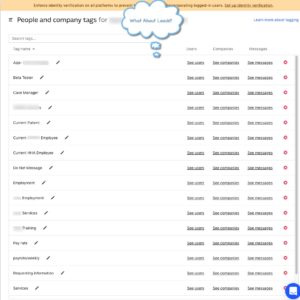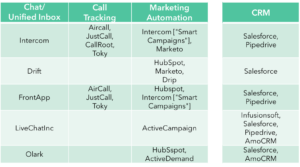If you’re a small or medium size business selling to consumers, you probably want to both automate and personalize your marketing campaigns. The solution, of course, is marketing automation linked to your customer relationship management (CRM) software.
Fortunately for SMB marketers, CRM is becoming main stream. According to a recent Wall Street Journal story, “…almost 37% of small businesses are ‘fully adapted’ to cloud-based applications.” And Steve King, a partner with Emergent research, predicts that to increase to 78% of small businesses by 2020.
You likely depend upon CRM software to run your entire business.
Marketing automation combined with CRM is a real benefit to sales organizations. Leads with CRM data are better qualified and therefore easier to close. Here’s why:
- Your sales conversations are more familiar and personal when your inbound sales team can reference notes of previous interactions. A shared history creates deeper relationships.
- Your emails are more relevant. More likely to elicit a response…and less likely to be unsubscribed.
- You can remarket ads more intelligently based on specific interests or positions in the sales funnel.
These are compelling, important benefits. Just not for companies with a closed, proprietary CRM.
The Disconnect
While general-purpose CRM (like Zoho, Salesforce or Pipedrive) play well with marketing automation platforms, many B2C businesses use proprietary CRMs, purpose built for specific industries: pest control, home health aides, dentistry, and dozens of others.
These systems embody decades of esoteric, business-process knowledge. But they’re years behind in terms of pre-customer, top-of-the-funnel campaigning.
Here’s the wish list for a centralized marketing hub to receive, segment, then communicate to prospects.
– Preserve a record of all interactions with a prospect
– Allow agents to tag and segment prospects based on interest or funnel position.
– Automatically detect and prevent duplicate records.
– Automatically message prospects in the pipeline, especially by email.
– Tailor marketing messages based on visits to specific web pages, or a threshold of pageviews.
– Conduct drip email, SMS or Facebook ad campaigns based on segments.
Proprietary CRMs have key roadblocks that prevent you from getting those benefits.
– No (or limited) web-to-lead forms
– No conversion signal to Google Analytics or AdWords
– No support for call tracking
– No support for email campaigning
– No support for SMS
– No support for online chat
– No support for Facebook lead ads.
Worse, information gets stuck in an air gap when a lead becomes a customer. One of our clients must literally retype contact and account information into their proprietary CRM when creating a new customer record.
We’re currently working with a client to find solutions to this seemingly simple issue: how to implement a marketing automation platform without connecting to a proprietary CRM or maintaining a parallel (and redundant) CRM. They do not want staff to waste time maintaining two separate CRMs: one for pre-customers alongside the real CRM.
What we’ve learned (and still are learning) could be useful to other companies with similar challenges.
Three Platforms; One (Potential) Solution
There seem to be three different platforms vying for the role of ‘non-CRM marketing hub’ for SMBs.
- Call tracking hub
- Email marketing hub
- Chat hub
Let’s review the pros and cons of each:
Call Tracking Hub
According to Salesforce.com, 92% of customer interactions happen on the phone.
Many consumer-facing businesses rely principally on phone calls, and increasingly chat and SMS.
Web-based cookies and pixels are associated to phone calls and SMS by call tracking services (CallRail, PhoneWagon, Aircall).
However, tracking numbers applied to offline marketing (brochures, signage, print ads), lack a digital footprint, so manual tagging of leads is required.
That’s where things fall apart. Call tracking vendors expect users to use a CRM. Some vendors (CallRail) offer a rudimentary, quasi-CRM app (LeadCenter), that lacks the robust tools needed for true marketing automation.
And most call tracking vendors don’t (and realistically won’t) build connections to hundreds of proprietary CRMs.
(During our research, we identified one vendor – LeadsBridge – that is attempting to close this air gap by offering integration services to proprietary CRMs with an API. But even that is not assured. Some CRM vendors make API access a profit center while others lack an API.)
CallRail offers a web-form submission option that works with its dynamic number insertion (DNI) script. Without a more robust CRM app, the information can’t be easily exploited for things like targeted email, SMS or Facebook ad campaigns.
Email Hub
Of course, email campaigning is the heart of marketing automation. One potential solution is to use your email campaign manager as a centralized hub for prospect information. Unfortunately, most email campaign platforms (MailChimp, Constant Contact) are really not designed for this purpose.
The good news is that feed form submissions can be easily segmented. And prospects can be automatically migrated from one list to another based on responses and/or actions. Some mail campaign apps now offer a Facebook ad campaign builder.
The obvious downside is when a majority of leads are phone calls. Mail campaign software really isn’t designed to store tracked call, SMS or chat transcripts or recordings. Further, inbound phone agents may find it difficult to create new prospect records if prospects are loathe to give out their email address.
Finally, emails can be slow, get lost in a spam trap or ignored. Too often, if initial contact does not result in a sale, the opportunity is lost as well.
One problem that plagues both approaches is duplicates. Consumers do the darnedest things. They may call in on a tracked number, but then carry on a text conversation using the same number. Then switch to online chat (or a chat bot), then Facebook Messenger.
The challenge is to keep all this interaction straight. Most CRM software have native integrations with popular call tracking services. These will help dedupe repeat calls by recognizing the original caller. But these don’t always work seamlessly (when a prospect uses a 2nd phone), and obviously can’t work when web forms don’t have a phone number.
Services like Zapier promise to connect apps without an IT staff. The truth is that the details (like how to prevent dupes) are monumental.
Chat-Based Hub
Based on our admittedly short research, chat messaging platforms could actually be the best solution to create marketing automation without CRM.
First, live chat, auto responders and bots are increasingly popular, replacing web-to-lead forms and even phone calls. Econsultancy discovered that 73% of customers were satisfied with their live chat experience, compared to just 61% of email users and a 44% of phone users.
Chat platforms can keep transcripts of ALL interactions (email; chat) + campaign responses, so leads have more credibility with sales.
Most chat platforms allow the inbound agent to tag calls & segment prospects. They support email campaigning with conditional workflows. With proper setup (and native integrations), they can dedupe most prospect records without human intervention.
Most importantly, chat platforms are beginning to recognize the importance of omni-channel communications and have added support for phone and SMS.
Intercom.io recently announced a native integration with AirCall, which allows voice and SMS interactions to be stored alongside chat, email and Facebook Messenger). They also raised $125 million on the strength of their “messenger-first” approach to sales software, which their CEO touts is responsible for an “81% greater conversion rate”.
Callrail recently updated its integration with Hubspot (arguably another non-CRM hub), to send phone calls and text messages directly into HubSpot’s “engagements” API. This allows users to add a phone call to a contact, allows new contacts to be created from phone calls without email addresses, and appends call recordings directly to HubSpot contacts.
One vendor already building a chat-based hub is Podium. Their online reviews platform connects to proprietary CRMs for healthcare (Dentrix, OpenDental, Eaglesoft), automotive (CDK, Dealer Socket, DealerTrack), home services (ServiceTitan, ServSuite, Housecall Pro) and a few retail systems (Furniture Wizard, Lightspeed, SPOT, STORIS ). Podium also supports Google Click-to-Message Ads, Facebook Messenger and SMS conversations. They also just announced that it has included web chat as part of its enterprise messaging platform. Unfortunately, no call integrations and no campaigning.
Chat as hub is not a perfect solution for non-CRM marketing automation. For example, in Intercom.io’s world, “users” are registered customers or trial users (like SaaS subscribers) with a login ID and password. Perfect if you are selling enterprise SaaS software. Not real useful if you are a plumber.
Still, if you have a closed CRM and still want to benefit from unified inbox communications with prospects, here’s a list of chat platforms worth checking out: Intercom, Podium, Drift, Chat.io/LiveChatInc, Olark and FrontApp.








